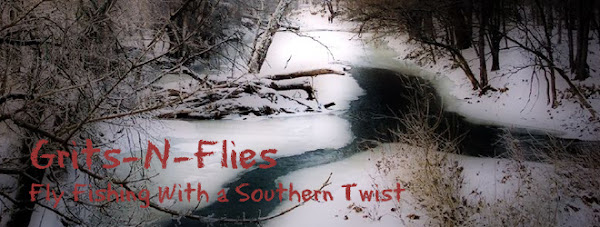It was spiting snow when I crossed the top of the divide heading into the Freestone Valley on Monday. The the muddy ruts in the road were frozen and covered with a dusting of snow. It seemed like a typical January morning. With the temperatures hovering around freezing, I knew I would be in for a tough day of fishing.
This cold January morning had me heading into uncharted territory, I had never been in this part of Virginia before. The Freestone Valley, which lies in the southeastern most corner of Tazewell county, is home to one of the tributaries of the North Fork of the Holston River. Laurel Creek, along with three or four other larger streams in the area, eventually forms the North Fork of the Holston River.
Laurel Creek is one of a hand full of streams that feed the North Fork and hold trout. Two of these are Roaring Fork and Lick Creek. All of these streams are know to hold Rainbows and Brooks.
Laurel Creek would be ideal for those looking for semi-remote fishing. The creek appears to get a low amount of pressure and has access to most of it by FR 222. This road winds it’s way through the Jefferson National Forest from highway 16 and it is nice on a cold day having the truck close by.
By midmorning I was easing up on a beaver pond that was a short way down stream from where I first caught glimpse of Laurel 
I could tell the stream was swollen from the inch and a half of rain we had received the week before, and the six plus inches in the past month. The leaves had been striped way along the bank revealing the dark soil and indicating the water was receding.
All morning I used searching patterns and an across stream swing presentation as I tried to locate the trout. I covered the whole pond and didn’t even see one fish. I began to get disappointed but all the while reminding my self ‘winter fishing is tough.’
Breaking the ice out of my guides was a constant reminder of just how cold it was. Even the more was when I began to dig in the 
When lunch time rolled around I drove down stream to a place where the stream wondered through an open area and finished my lunch. I had pack a lunch, knowing after looking at a map I would not be close to much, of tuna and a hardboiled egg. It’s not much as table fare but it will get you through the day.
After I ate I headed over to the stream. This section meandered back and forth through this flat open area. The water went from short riffles, to even shorter pools, and then into a hard turns all throughout this clearing. I was constantly changing my location and hopping from one side of the stream to the other.
Removing the 7x leader and rigging from the morning, I tied on a 4x leader and a conehead sculpin pattern. Switching back and forth between a between an upstream pitch and strip, and an across stream swing I managed to stir up some strikes but no takers.
It was a great day and definitely a stream I would fish again. Between the solitude and the beauty of the the landscape, Laurel Creek is one of those places you just keep coming back too.
The sections that I fished where part of the upper reaches of this branch. According to Trout Streams of Virginia: An Angler's Guide to the Blue Ridge Watershed the better sections are from the bridge, where Roaring Fork enters, down stream to where National Forest meets private property. This section is better accessed from highway 601 off of Virginia 16.
If you decide to fish Laurel Fork be sure to plan ahead. The area is fairly remote. There is no cell phone signal and no apparent permanent residents. If you get stranded it is a couple mile hike up hill to highway 16 from the stocked waters. Be sure to pack a lunch, no restaurants or service stations are close by to stop at for lunch.
Before you go fill your fly box full of streamer patterns from sizes 16 down to size 10. I would take patterns like the sculpin, Mickey Fin, muddler, and the sliver darter. I would also take along a few caddisflies in sizes 14-18. If you go in late summer to early fall be sure to take a few terrestrials along.
Be careful the stream is narrow but I found its depth deceiving. More than once I found myself in deeper water than it appeared.
Laurel Creek was a lot of fun and I would go again. My day ended fishless, cloudy, and cold (basically, the way it began). Don’t let my down day in the middle of January stop you. Good water lies in the Freestone Valley and plenty of elbow room give it a try and let me know what you think.
_____________________
Keep up with Grits-N-Flies and the streams he fishes by subscribing to the Grits-N-Flies RSS.
If you missed last week’s post on Wolf Creek you can find it here.
Information on Jefferson National Forest is available here.
Virginia trout stocking information is available here.
The above link is updated weekly. You can search through the archives for past stockings.
The closest weather station available is in Bland, Virginia.




2 comments:
Just ran across your blog. Great pics and stories. I used to live in VA and miss discovering all the beautiful little rivers and streams in the VA, PA, MD and WV area. There was always somewhere new to go. I live in Texas now (sad, one trout stream in the whole state) but plan to get back to VA soon. Keep the posts coming.
Tight Lines,
Dean Burris
www.anglerwannabe.com
Thanks Dean, I'll do my best.
Post a Comment